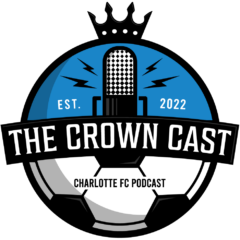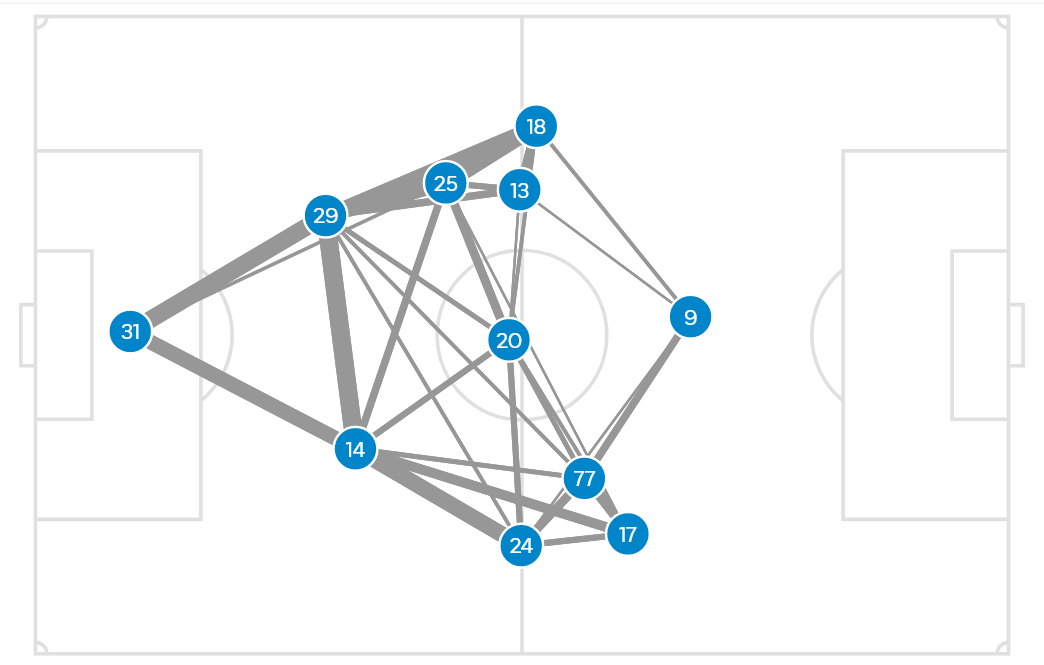It’s fair to say that the start of this season hasn’t been great. It also isn’t dissimilar to last year. Under MAR, Charlotte began its inaugural campaign with 3 losses but followed that up with 3 wins in the next four matches (the lone non-win being a loss away at Philadelphia).
It’s hard to remember now, but Charlotte played some pretty good football at the end of the year in 2022 as they made their push to sneak into the playoffs. Ultimately, that push came up short, but it gave me a lot of hope for this year. It seemed a template was set. This year, though, there has been a chopping and changing of personnel and the results have been…erratic.
One of the issues that we’ve discussed here–and has been discussed ad nauseam amongst the entire fanbase–is the formation and personnel that are playing or should be played. What seems more important to me, though, is how that personnel and formations are actually being executed in game.
One of the ways we can view this is by looking at passing networks. They’re what the name implies: visuals that illustrate the passing connections between players. MLS is kind enough to have them for every game. Indeed, they’re much more interactive on MLS’s website (for instance, if you hover your cursor over a line, it will tell you the number of passes between players, in both directions). While screenshotting these networks and putting them here takes away some of the interactivity, it doesn’t take away the usefulness.
A few things to consider:
- There is some cutoff for passing networks. What I mean by that is, if you take Atlanta’s passing map from our game this year (found here), you will see that Miguel Berry (#19) has literally no lines connecting him to any of his teammates. That would seem to imply that he never completed a pass. That’s inaccurate. You can go to FBref (here) and see that he actually completed 6/6 passes. That’s obviously not a ton of passes for a player who played 58 minutes, but it’s not zero. Just because there is no line, doesn’t mean there wasn’t any connection; just that the connection was too small to be relevant.
- Thicker lines indicate more passes between players.
- Player positions on these maps are relative and an average of where they were. These networks should not be viewed as a measure of the areas a player took positions up in. Look to heatmaps for a better visual of that.
- Some passing networks will have larger dots or smaller dots for players to denote how many passes that player attempted. MLS does not do that.
With those caveats out of the way, let’s actually look at some networks for Charlotte, both from this year and last*.
*Note: I have taken the last 4 games of Charlotte’s 2022 season, but replaced the home NYCFC game for Columbus. That Columbus game was technically the 2nd to last game for us, but due to it being split over multiple days for the weather delay, and the vast change in personnel from when it was started to when it ended, I thought it better to ignore.
2022 Passing Networks: NYCF, CHI, PHI, and RBNY
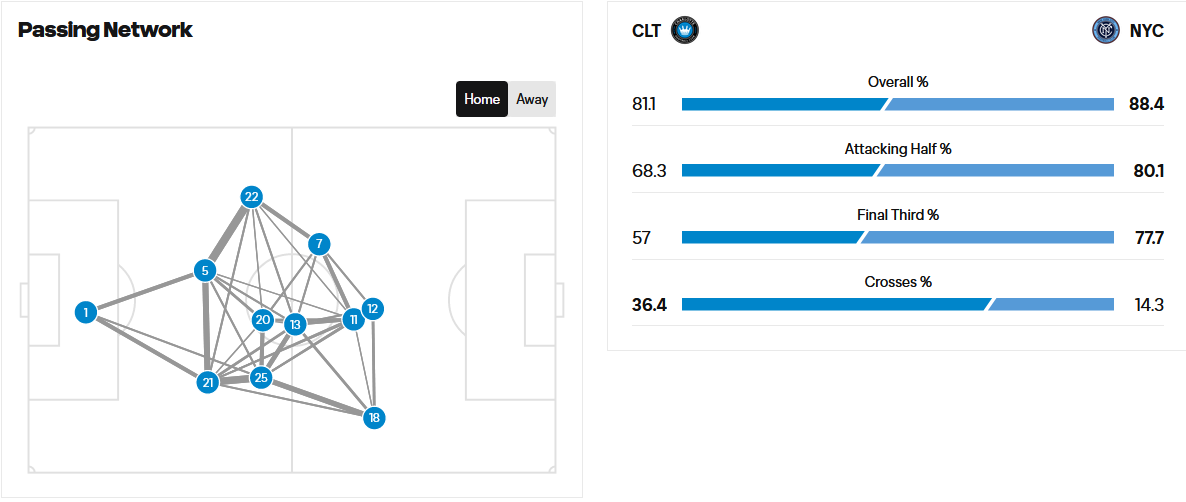
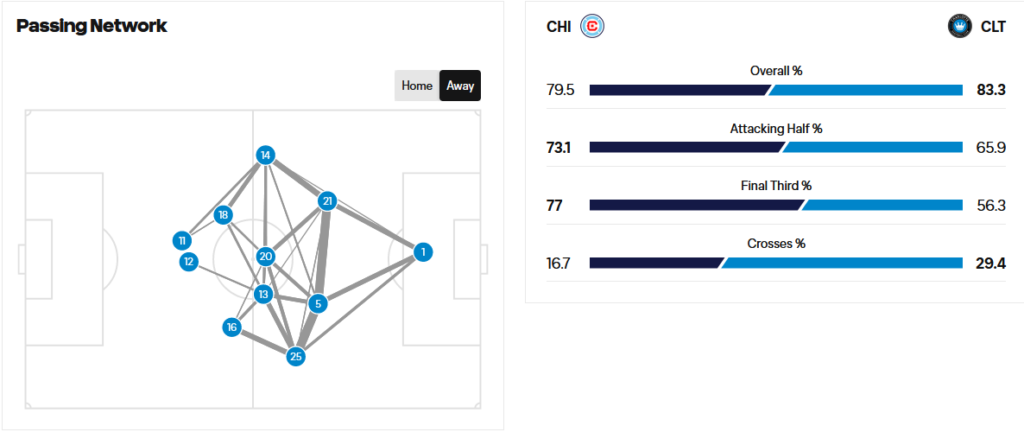

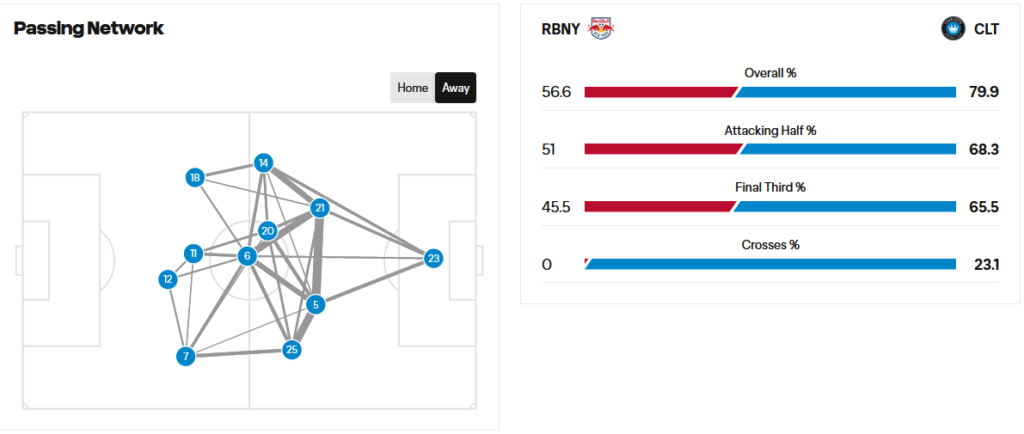
2023 Passing Networks: NE, STL, ATL, ORL, and RBNY
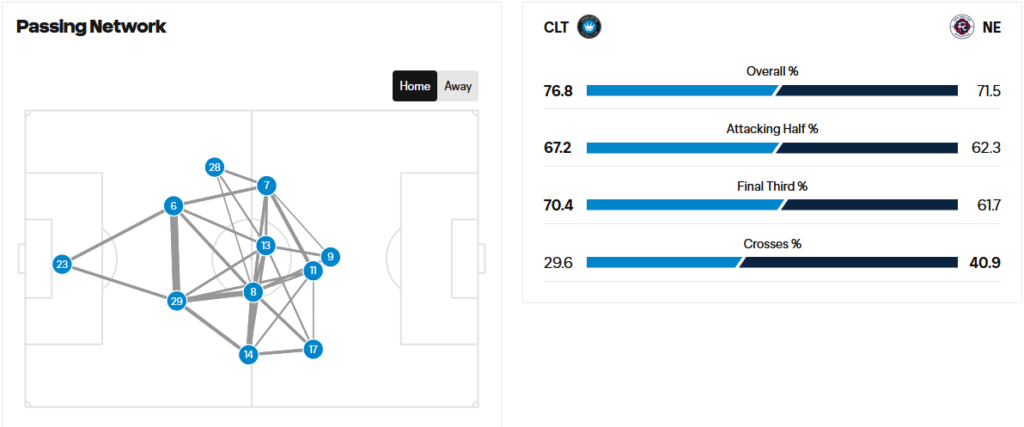
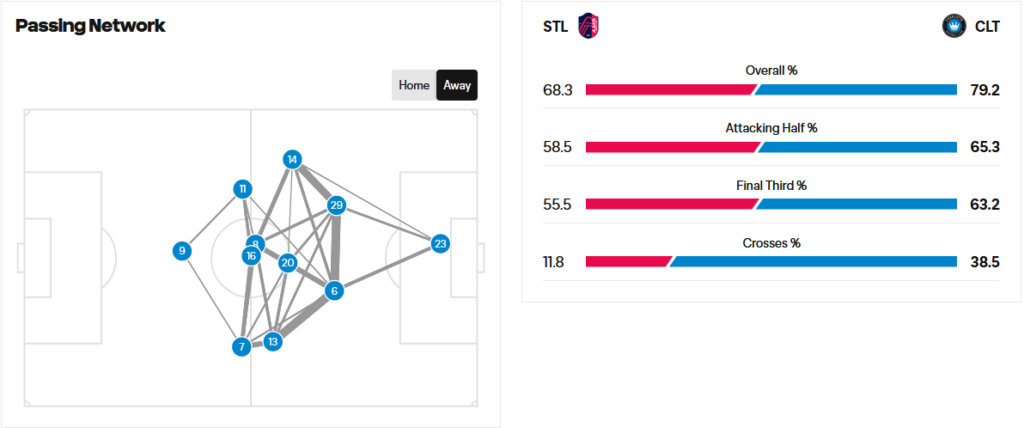
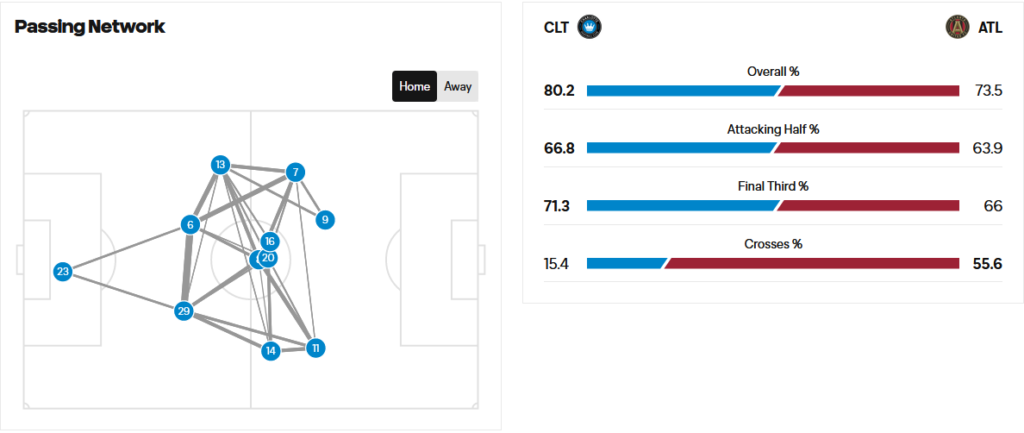
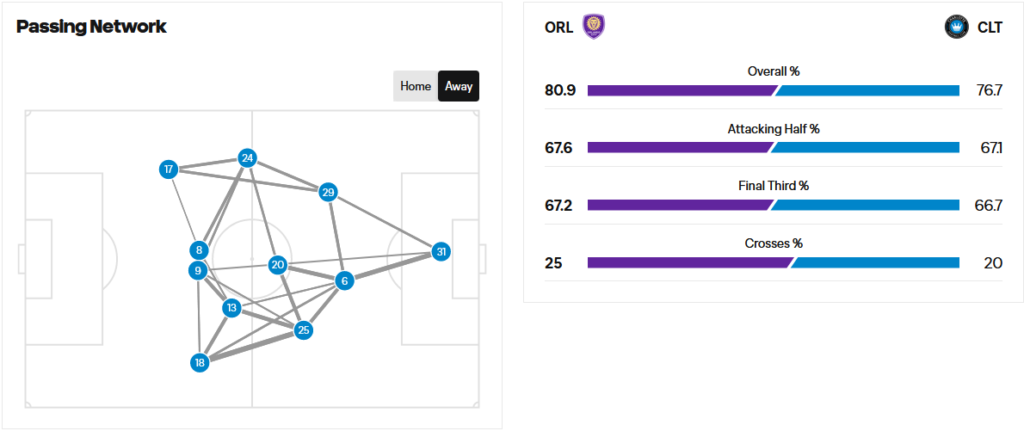
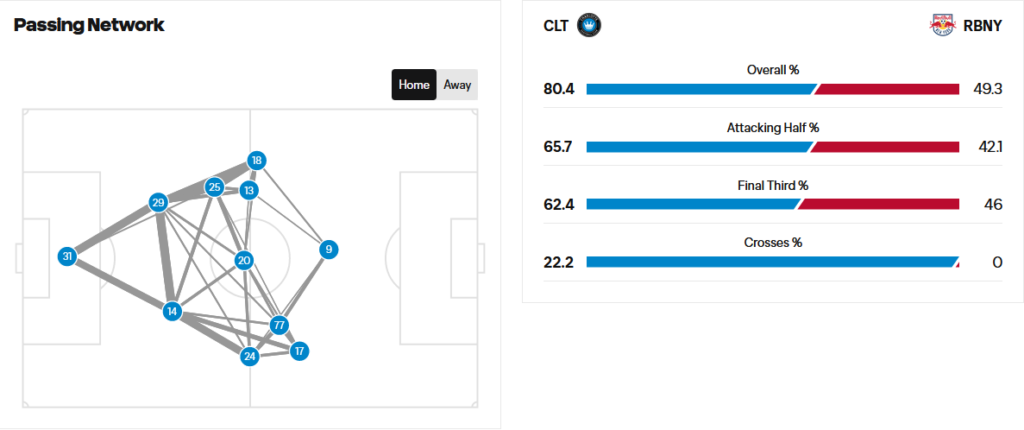
Striker Isolation
So that’s a lot of visuals, where do we start?
When viewing the networks from last year’s games, one of the first things that jumped out to me is the relative proximity of Karol Świderski and Daniel Ríos. The home game against Philadelphia has them the furthest apart from each other, but they are still relatively close. In the NYCFC and Chicago games, they are practically on top of one another. Interestingly, Karol is ahead of Ríos in that Chicago game, too. Then, in the RBNY game, they’re not quite as close, but still pretty darn close.
What’s also interesting is that even though each is taking up similar positions and playing close to one another, they are not passing to one another. In the NYCFC network, Karol is literally on top of Ríos, so it’s actually impossible to know if there was a connection, but I don’t believe there was. There is no line for the Chicago or Philadelphia game, and the small line against RBNY represents 6 total passes between them (3 each way). Again, this doesn’t mean that against Chicago or Philadelphia they never passed to each other, just that it happened so little there is no line to represent it. But the proximity in which they played clearly benefited the team. Charlotte scored 8 total goals over these games (RBNY was a shutout, but the team had nothing to play for and I think it showed).
Now, compare this proximity between striker and CAM with the maps from this year. Immediately you notice just how isolated Enzo Copetti is.
Against New England to begin the season, the positioning does look similar to the end of last year. However, against St. Louis, with Karol switched out wide and Andre Shinyashiki replacing him in that forward 8/central attacking midfielder role, Enzo is by himself up top. Against Atlanta, Enzo has Jóźwiak for company, but worryingly–and absurdly–there is no connection between anyone in our midfield and Enzo. Orlando, which has probably been the best display of attack we’ve had all season (that’s not saying a lot), has him playing right next to Ashley Westwood. Again, the two dots are so close it’s impossible to tell if there is a connection. Finally, against RBNY, Copetti is again a man by himself. Clearly, one of the early season issues for this team is the isolation of our striker up top.
Midfield Cluster and Lack of Width
Now, Enzo might find himself in acres of space with nary a friendly face to be seen, but our midfielders certainly don’t have that problem. At least this is true in the 2 worst games we’ve played all year: St. Louis and Atlanta. Look at the ridiculousness in those games. Against St. Louis, Andre is almost covering Westwood, while Derrick Jones is slightly behind. Against Atlanta, you literally can’t see Westwood’s number (it is him), as DJ’s is completely covering it. Andre, meanwhile, is overlapping DJ.
Those two games highlight another issue we’ve been having, though one that I believe CL is working to solve: the narrowness of this team. St. Louis probably represents the extreme of this. Look at that game’s network compared with Orlando’s, which comes 2 weeks later. The width that is being held by players like Gaines and Byrne on the right in Orlando and Vargas on the left is a sight for sore eyes.
When you look back at the 2022 networks, you see that there is always at least one player who is holding width with the exception of the game against Philadelphia: Gaines against NYCFC; Byrne (and to a lesser degree Afful) against Chicago; and Jóźwiak and Byrne against RBNY. Now, I will admit that against Philadelphia, we are playing a bit narrower than in the other games, so there are times when you can set a team up that way and find success. For this team, though, that is an exception.
Pinned Back
Coupled with the above width and midfield issue is the issue of how deeply our team is being pinned back, especially our wingers. New England to open at least has Gaines and Świderski trying to join Copetti, but against St. Louis, no one but Enzo is beyond the halfway line. Against Atlanta, it’s a bit better, but still not great. Again, Orlando is probably our best attacking performance of the season and we finally see players taking positions up the pitch. We revert against RBNY, though. Gaines, Nuno, and Byrne are all clustered together holding the width, but only Nuno and Gaines are taking up positions beyond the halfway line, and barely at that. Again, compare this to those 2022 maps where we consistently have 4 players in the opponent’s half.
For a team that wants to hit on the counter, maybe these kinds of networks would be fine, especially when it comes to player positions. That is not Christian Lattanzio’s Charlotte. Here are our possession percentages by game:
- 54.40% against NE
- 61.00% against STL
- 55.80% against ATL
- 44.60% against ORL
- 74.00% against RBNY
Some of those possession numbers are absolutely wild, yet we are literally doing nothing with them. This team has scored 4 goals on the year, and one of those was an own goal.
Next Steps
So what do we do about this? Well, I’m not an expert on tactics. I point you to Euan’s excellent piece on our tactics in the wake of the Atlanta loss for someone who knows that subject much better than I do. What I will say is that I view this post as a companion piece to that one. We’re looking at the same issues through different lenses, so many of my conclusions align with what Euan said in that piece, though I don’t pretend to speak for him (please read his piece for his thoughts!).
First, Świderski needs to be back in as the attacking 8 or CAM (whatever you want to call it due to whatever formation you want to say we’re playing). Enzo Copetti has been far too isolated and needs someone else to help occupy defenders. Our best football under Lattanzio has come with him as a pseudo-striker who can drop deep, link play, and then make forward runs.
I’m a big, BIG fan of Nuno Santos and I want to see more of him, but also, maybe that game against Orlando shows us why he hasn’t been picked? I’ll caveat what I’m going to say next with “small sample size,” but if those are the areas that Nuno likes to drift into, then it makes more sense as to why he hasn’t been selected.
Second, the emphasis on width that we’ve seen in the last two games has to continue. It was apparent to me within the first 10 minutes of the Red Bulls’ game that Vargas and Gaines had been told to stay wide. It’s something that we did last year with at least one of our wingers and should continue. Vargas, I think, is the key here. If he’s on the left, then you need your right winger to stay touchline tight, regardless of if it’s Gaines, Jóźwiak, or Mello. If Vargas is on the right, I’d probably have him fill that role, while allowing Jóźwiak on the left to cut in.
As Justin likes to say, all our wingers are better on the left. I’ll add to that that we have a lot of wingers who prefer to cut inside. For some teams, you could allow both wings to cut in and keep width with overlapping FBs. As I’ve talked nonstop about, CL doesn’t want that; he wants his FBs inverted.
While I believe that Vargas could provide width effectively, it’s probably not the best use of his full talents. We’ve seen time and again how good his right foot is. Allowing him the opportunity to cut in onto it from the left makes a ton of sense. If we could combine his right foot with Świderski’s left, we’d have a player who would’ve been way too good to ever play for us!
Third, improve the spacing in the midfield. With more width provided by at least 1 winger, we need to see Westwood or Bronico further from Jones and whatever left-back is tucking into the midfield (I’m assuming for the time being that will be Afful). Orlando’s passing network is probably the best version of this so far. It should be noted that, of course, there are times when midfielders can be close (see: Bronico and Jones against Philadelphia last year), but what we’ve seen in the St. Louis and Atlanta games can’t happen again.
These networks are just one way to look at this team, but they confirm issues that we are seeing in-game, namely, that our possession is toothless and our passing is largely harmless. Euan asked the question of why Lattanzio changed his tactics from what seemed to be working so well at the end of last year. Like him, I can’t fully answer that. I do think we’re starting to see a shift back to some of those end-of-year principles, though. Hopefully, Saturday sees a continuation of the improvement the team has shown over the past couple of games (at least compared to the first few).
April offers a chance to erase the poor start. Toronto has only 1 win on the season (though 3 draws) and is missing Lorenzo Insigne. Real Salt Lake has 1 win and 3 losses, with a -6 GD (we only have -5!). Colorado sits bottom of the West with 2 draws and 3 losses. Columbus…well, they just thrashed Atlanta and will probably have Cucho back by our game (lucky us!), so it’ll be tough. DC ends the month. They have just 1 win and only beat us in the standings due to a slightly better GD.
Something like 2 wins, 2 draws, and a loss in those games would feel pretty good. Something like 3 wins and 2 draws would really change some feelings around here. Fortunately, or possibly unfortunately, by the end of next month, we’ll probably have a pretty good idea of if this team has a realistic shot to make the playoffs. Let’s hope it’s a good April.
Data Notes: All heatmaps come fromSofascore.com. All percentile rankings and percentile charts come fromFBref.com. All formation graphics are fromMLSsoccer.com. Other websites used for data include transfermarkt.us,Wyscout.com, andMLSsoccer.com.
